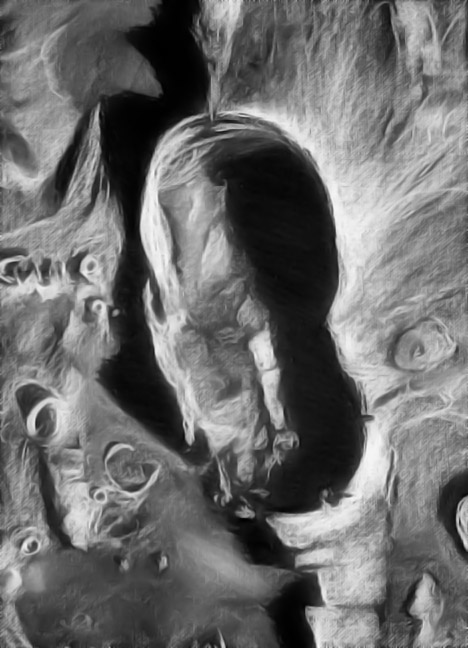
drawing by Richard Handy
In the south western quadrant of the Moon, amidst the heavily bombarded highland terra and adjacent to Lacus Timoris (the poetically named “Lake of Time”), lies the trio of complex overlapping craters, Hainzel, Hainzel A and C. A quick look at this grouping in this lighting may leave one with the mistaken impression that these three are the result of a single asteriod that broke into a couple of major chunks just prior to impact, resulting in the elongate structure without an obvious wall separating the two larger impacts. Despite that appearance, however, each crater was formed at a different epoch. 78 km Hainzel which comprises a good portion of the southern portion of the “fiddle” shaped complex is a Nectarian era feature, formed sometime between 3,920 and 3,850 million years ago. In my sketch you can see that indeed, the lower crater has taken several impacts to its rim. In contrast, 38 km Hainzel A above it, is a relatively youthful Erastosthenian era crater formed between 3,200 and 1,100 million years ago. Here again its youth can be gaged by the very fresh looking glacis, shown in my sketch as the ropey and branching area to the upper right of Hainzel A’s rim (the upper body of the fiddle). The drawing shows few superposed craters in this large area, a definite indicator of freshness. 19 km by 28 km Hainzel C is an Imbrium era crater formed during the gap in time between Hainzel and Hainzel A’s appearance between about 3,800 million and 3,200 million years ago. The light was not favorable for a good look at C, covered as it was by deep shadow from it’s bigger brothers. Previous views of C showed a damaged and disrupted floor and walls, most probably the result of the impact of A.
Richard Handy
Technical Details
10-2-06; 4:24 UT-5:43 UT. Seeing: Antoniadi III-IV Weather clear, light breeze. Lunation: 10.65 days. Phase: 55.7 deg Colongitude: 39.5 deg. Illumination: 78.2%. Lib in Lat: +4 deg 55 min; Lib. in Long: -5 deg 11 min. Telescope: 12″ Meade SCT, f/10. Binoviewers: W.O. Bino-P with 1.6X Nose piece. Eyepieces: 12.4 mm Meade series 4000 Super Plossls. Magnification: 393X. Sketch medium: White and black Conte’ Crayon on black textured Strathmore paper. Sketch size: 18″ x 24″ Note from CAW: I used the Photoshop Reduce Noise fiilter to remove the underlying canvas texture.
Related Links:
Rükl plate 63
How Richard makes his drawings
Hainzel
Yesterday's LPOD: A Very Tormented Floor
Tomorrow's LPOD: Headlights of Stevinus
COMMENTS?
Register, Log in, and join in the comments.



